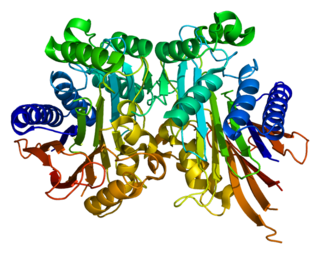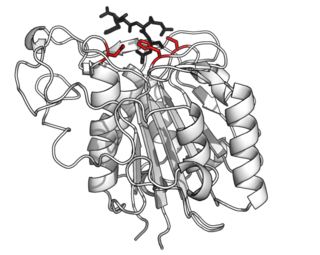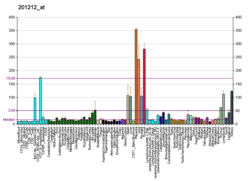
EGR-1 also known as ZNF268 or NGFI-A is a protein that in humans is encoded by the EGR1 gene.

Activating transcription factor 4 , also known as ATF4, is a protein that in humans is encoded by the ATF4 gene.

Y box binding protein 1 also known as Y-box transcription factor or nuclease-sensitive element-binding protein 1 is a protein that in humans is encoded by the YBX1 gene.

Latrophilin 2 is a protein that in humans is encoded by the ADGRL2 gene.

Cathepsin L1 is a protein that in humans is encoded by the CTSL1 gene. The protein is a cysteine cathepsin, a lysosomal cysteine protease that plays a major role in intracellular protein catabolism.

40S ribosomal protein S3a is a protein that in humans is encoded by the RPS3A gene.

Cathepsin H is a protein that in humans is encoded by the CTSH gene.

Protein SSX2 is a protein that in humans is encoded by the SSX2 gene.

Aspartyl/asparaginyl beta-hydroxylase (HAAH) is an enzyme that in humans is encoded by the ASPH gene. ASPH is an alpha-ketoglutarate-dependent hydroxylase, a superfamily non-haem iron-containing proteins.

60S ribosomal protein L36a is a protein that in humans is encoded by the RPL36A gene.

Krueppel-like factor 12 is a protein that in humans is encoded by the KLF12 gene.

Cathepsin L2,, is a protein encoded in humans by the CTSV gene.

Cathepsin W is a protein that in humans is encoded by the CTSW gene.

Asparaginyl-tRNA synthetase, cytoplasmic is an enzyme that in humans is encoded by the NARS gene.

Procollagen C-endopeptidase enhancer 2 is a protein that in humans is encoded by the PCOLCE2 gene.

Lysyl oxidase homolog 4 is an enzyme that in humans is encoded by the LOXL4 gene.

Cysteine-rich secretory protein 2 is a cysteine-rich secretory protein that in humans is encoded by the CRISP2 gene.

Threonine aspartase 1 is an enzyme that in humans is encoded by the TASP1 gene.

Chitobiosyldiphosphodolichol beta-mannosyltransferase is an enzyme that is encoded by ALG1 whose structure and function has been conserved from lower to higher organisms.

Asparagine endopeptidase is a proteolytic enzyme from C13 peptidase family which hydrolyses a peptide bond using the thiol group of a cysteine residue as a nucleophile. It is also known as asparaginyl endopeptidase, citvac, proteinase B, hemoglobinase, PRSC1 gene product or LGMN, vicilin peptidohydrolase and bean endopeptidase. In humans it is encoded by the LGMN gene.























